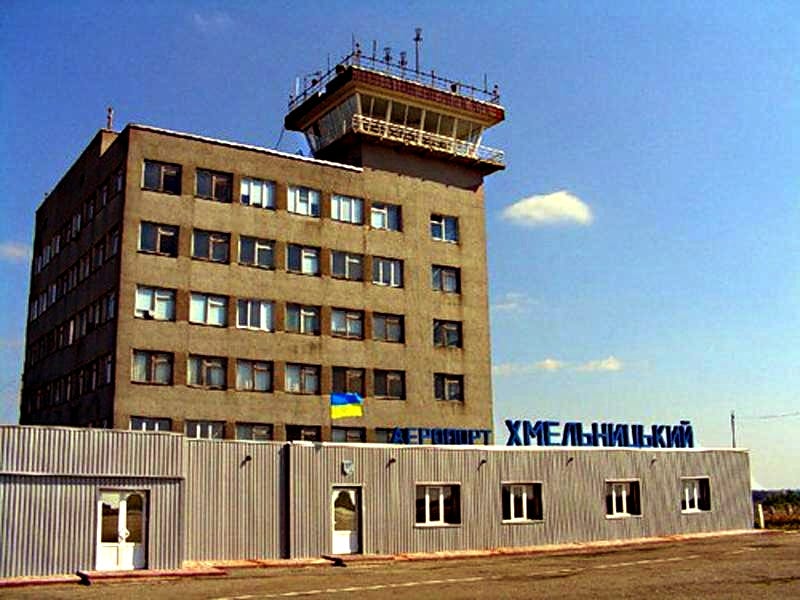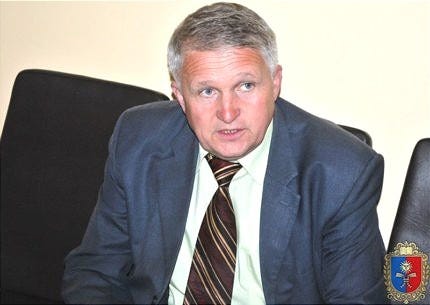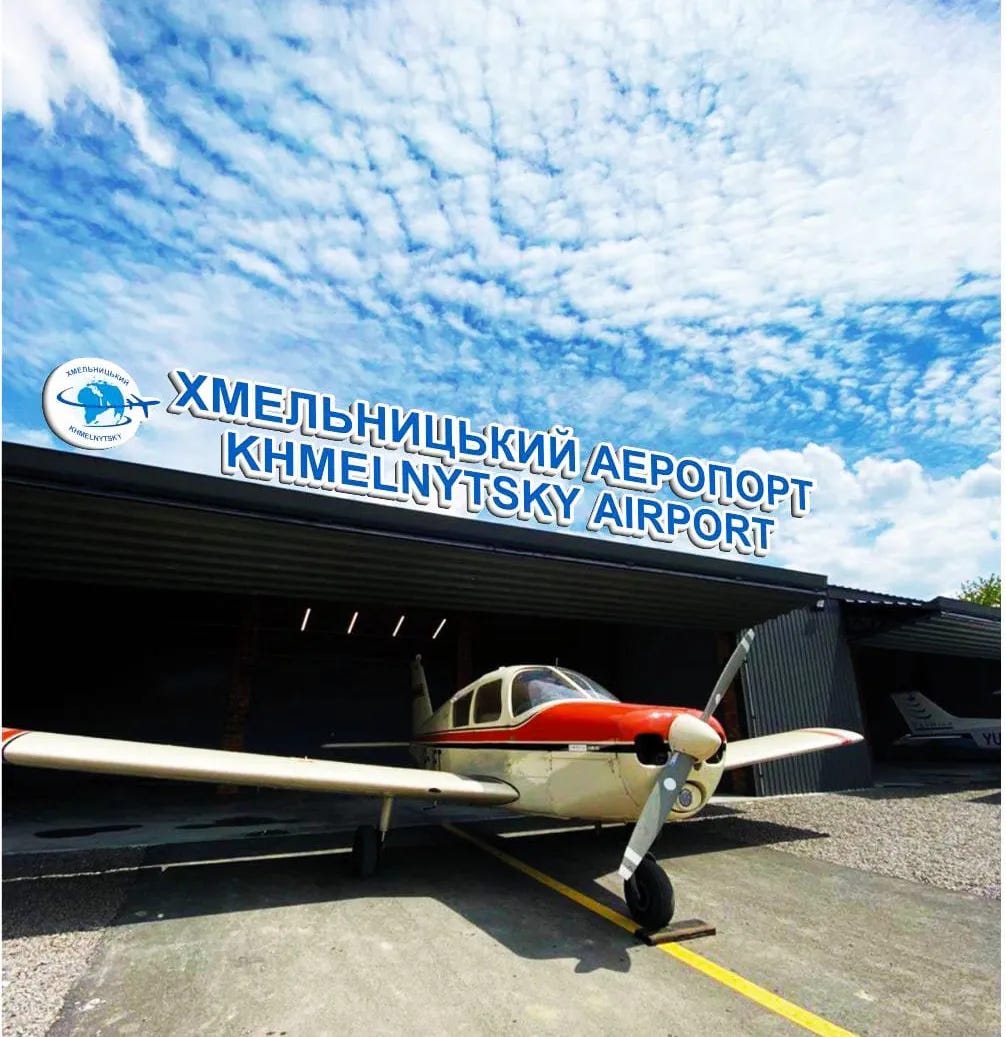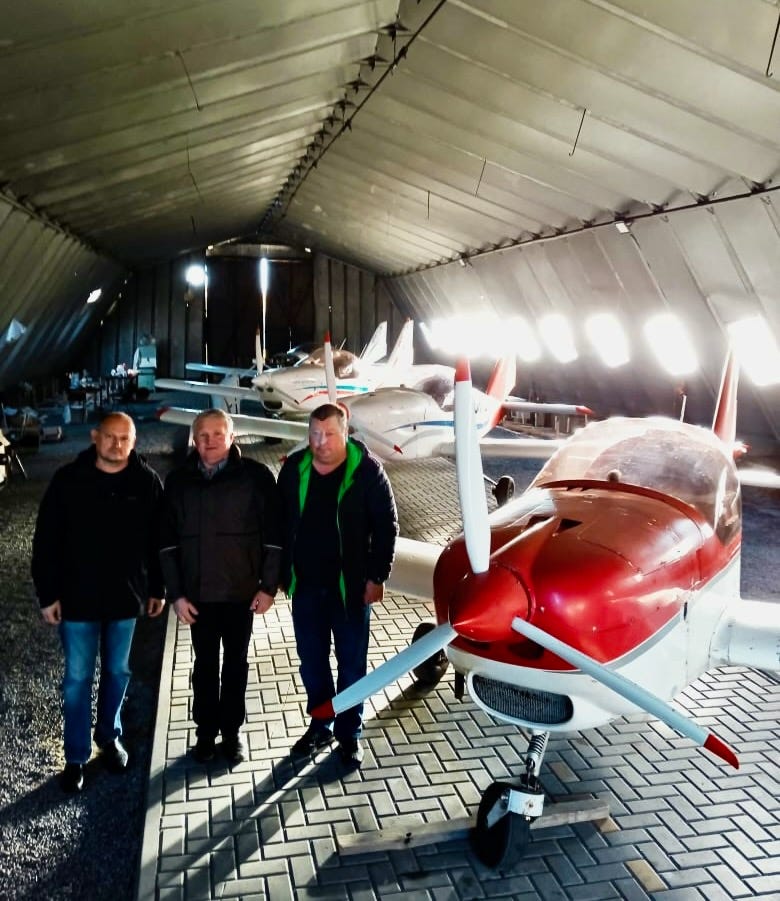Revival of Khmelnytskyi Airport: Challenges, Prospects, and Ambitions.
Exclusive Interview with Valerii Soroka, Director of Khmelnytskyi Airport
From the first Airmail in Europe to Decline.
The Khmelnytskyi Airport began its journey in 1914 as part of the international airmail route Vienna–Kyiv. Over time, it became an essential element of transportation infrastructure, serving both passenger and military needs.

Proskuriv is the old name of the city of Khmelnytskyi.
From 1944 to 1947, the Proskuriv Aviation Squadron was established in Khmelnytskyi, becoming a significant part of military aviation during that era. Under the control of military commanders, the organization and supervision of civil aviation were carried out, marking the beginning of significant changes in the region's aviation landscape.
By the 1950s, control over aviation had shifted to civilian leadership. The local branch of “Aeroflot” took responsibility for developing aviation services, but the names of the leaders from this period have unfortunately not been preserved in public records.
Ruzhichnyi is one of the 10 neighborhoods of Khmelnytskyi.
In 1982, construction of a new airport in Ruzhychna began, representing a milestone for the region. The airport operated under the leadership of Ivan Mazur, the first director of the new terminal. His contribution to the airport’s development was substantial, as it was under his management that flight services were organized, laying the foundation for future growth of aviation infrastructure.
Ukraine gained its independence on August 24, 1991.
However, after Ukraine gained independence, the airport faced significant challenges. In 1994, it was transferred to local community ownership, effectively depriving it of state support.
During the 1990s, the Khmelnytskyi Airport experienced a period of economic crisis, leading to the suspension of most flights and the fragmentation of its infrastructure. Temporary administrations managing the enterprise during this time failed to ensure its development. The names of the leaders from this period remain unknown due to the loss of documentation. From 2002 to 2004, Viktor Honchar attempted to reconstruct the runway, but due to insufficient funding, the projects remained incomplete. From 2004 to 2015, the airport was essentially non-operational. In 2016, Ihor Kryvolapov made initial attempts to revive it, focusing on clearing debts.
A new chapter began in 2021 when Valerii Soroka took over as director. His strategic vision is aimed at the full restoration of the airport: reconstructing the runway, establishing a flight school, and developing small aviation. Soroka actively attracts investors and promotes the region’s tourism and cargo potential, transforming the airport into a key transportation hub in Western Ukraine.
You now have a unique opportunity to hear the exclusive development story of the Khmelnytskyi Airport and Ukraine Aviation from its current director, Valerii Rostyslavovych Soroka.
“When I started working here in 2017, the territory was in a terrible state—overgrown with forest and burdened with debts amounting to 6,3 million hryvnias (equivalent to 1491730,13 Dollars)," recalls Valerii Soroka. “It was hard to believe that anything could be done with it. But we decided to give it a try, and today I’m confident it was the right decision.”
Challenge. Solution. Action.
N. Starosta: What are the main challenges regional airports in Ukraine, particularly Khmelnytskyi, face in achieving profitability? What strategies are you using to attract passengers?
“Unfortunately, for an airport to be profitable, it needs at least one million passengers per year. This is achievable for cities like Lviv, Kharkiv, Odesa, Dnipro, and Kyiv. The issue for regional airports is that they struggle to reach such numbers, but it’s something we must work on. Khmelnytskyi region is home to over a million people, and according to global statistics, around 20-26% of the population uses air services.
Khmelnytskyi has significant development potential. We need to set goals not only for residents but also for attracting passengers from other regions. Additionally, there are many avenues, including tourism and industrial enterprises, that can contribute to the airport's development.
For example, in Kamianets-Podilskyi, there used to be a cable factory, and regular cargo transportation created revenue opportunities for businesses.
Attracting low-cost carriers like Wizz Air and Ryanair is also crucial for development, as they offer affordable flights for the average passenger. However, airports need to be prepared for this.
The primary income for an airport comes from aviation fees. To collaborate with low-cost carriers, these fees must be kept to a minimum. For this reason, airports need to diversify their income streams, including through the development of small aviation. This can become a significant source of revenue, which can then be used to ensure aviation safety and pay salaries.”
V. Hrechukha: What opportunities do the development of cargo transportation, the establishment of customs facilities, and attracting investments present for the Khmelnytskyi Airport? How will this impact its financial stability and appeal to international companies?
“Cargo transportation is a critical area for development. We are working on establishing customs facilities and enabling customs clearance of goods, which will provide the airport with additional financial revenue. This will allow us to offer zero fees for low-cost carriers, facilitating both passenger and cargo transportation. Our goal is to create a model of a regional airport that thrives on cargo operations, not just passenger services.
The runway at Khmelnytskyi Airport is already 2,200 meters long, and we have developed a project to extend it to 2,700 meters, with a future goal of reaching 3,300 meters. This opens up significant opportunities for cargo transportation.
Near the airport, there are investment hubs, including Nova Poshta, Epicenter, and ATB terminals, as well as actively developing industrial parks. These developments also contribute to the growth of the airport. Being located near industrial parks provides immense potential for the airport’s future.”
N. Starosta: Mr.Soroka, what is your vision for the main direction of Khmelnytskyi Airport's development? Considering the experience of similar regional airports like Palanga or Liepaja, what steps do you consider essential for its future growth?
“Khmelnytskyi Airport has a complex history. Like many other regional airports, its modern story began in 1994, when part of the country’s airports were transferred to the ownership of local communities. At that time, Khmelnytskyi Airport came under regional communal ownership, while airports like Boryspil and Lviv remained state-owned. As a result, all financial projects were focused on state airports, leaving regional ones like ours dependent on local communities.
We face significant expenses to maintain the airport, and I am confident that not only Khmelnytskyi but other regional airports in Ternopil, Chernivtsi, Rivne, and Ivano-Frankivsk face the same challenges.
Another major issue is staffing. We can build an airport, but without professional personnel, we cannot ensure aviation safety and effective operations.
The government has not been able to financially support airport operations, and this issue is not unique to Khmelnytskyi. We must learn from the experiences of European airports, particularly in Poland, Austria, and the Czech Republic, where state structures are responsible for developing airports. Unfortunately, Ukraine lacks such structures.
Currently, there is significant attention on developing regional airports, and our Association "Airports of Ukraine" of civil aviation is actively working in this direction. We hope the government will listen to us and establish a state agency to coordinate efforts. However, over the past two years of the pandemic and three years of war, much of the skilled workforce from operational airports has moved to Europe.
Today, airports like Lviv and Boryspil are funded by the state budget, while regional airports are merely surviving. This creates challenges in paying wages and retaining specialists.
In Khmelnytskyi, we face this issue. We needed airfield workers, navigators, and communication specialists, but when we approached local educational institutions through the employment centre, we could not find a single candidate. As a result, we initiated open-door events for high school graduates and signed an agreement with the Aviation Institute in Kyiv to support young people interested in aviation.
However, there’s a challenge: when we send a graduate for training, after completing their education, Boryspil Airport might offer better working conditions. Therefore, we need to create an incentive mechanism to foster a sense of patriotic responsibility.
Specialists, from security personnel to top management, must continuously learn and adopt the practices of European airports. Aviation safety relies on three key elements: passenger safety, aircraft safety, and workforce safety. People must constantly improve their knowledge. Aviation is always evolving, with changing requirements, so we must focus on continuous development.”
V. Hrechukha: What opportunities do the concession model and public-private partnerships provide for attracting investments, and how do they support the development of airport infrastructure?
“We have two options: the legislation on municipal property concessions and the legislation on public-private partnerships. Public-private partnerships involve the participation of both the state and private capital. This approach allows for funding from both sides but is more complex to implement.
In my opinion, the concession model is more effective because it allows an investor to submit a request to the regional council to transfer the airport into concession management. This approach provides a clear framework for defining the obligations of each party. The concession period can vary, ranging from three to 49 years.
For example, in 2021, we held negotiations with a Turkish company that planned to create a cargo-passenger hub and aimed to achieve profitability within seven years.”
N. Starosta: What are the main advantages of the concession model compared to public-private partnerships, and why is this model considered better for Khmelnytskyi Airport?
“The concession model provides greater flexibility and transparency. Investors pay concession fees, which function like rent but come with long-term guarantees. This encourages them to invest, quickly develop infrastructure, and make the project profitable.
The key advantage of the concession model is that the property transferred to the investor remains municipal, while anything they build becomes their property. This approach attracts significant investments because investors are motivated by long-term cooperation and development. At the same time, the airport’s municipal status ensures that the state retains control over key assets.”
N. Starosta: Is the financing for the reconstruction of the runway at Khmelnytskyi Airport solely the responsibility of the state, or does it depend on investors within the concession framework?
“No, it is not solely the state. The state determines the operator and sets the conditions, but our airport is municipal, not state-owned. That is why I have always urged the regional leadership to repair and extend the runway to ensure future development opportunities.
When a concessionaire steps in, they can create everything at their own expense, from airfield equipment to facilities and personnel services. If an investor is keen on rapid development, as practice shows, they are willing to invest their own funds in runway reconstruction. This slightly extends the project's payback period but allows the investor to plan and build infrastructure tailored to their needs and the demands of airlines.
If the reconstruction is done by the state and the investor comes in later, there’s a risk that the infrastructure may not align with their strategy. This could raise questions about the feasibility of the concession. That’s why it’s crucial for the concessionaire to participate directly in infrastructure development—this ensures long-term efficiency.”
V. Hrechukha: How does Khmelnytskyi Airport define its niche in the face of competition with major hubs like Boryspil and Lviv?
“We will never be like Boryspil or Vienna, and we shouldn’t aspire to that. Their concept is entirely different—they are central airports handling massive passenger flows. Our task is to find our niche and become partners for such hubs(Cargo).
Unfortunately, it sometimes feels like central executive authorities aim to leave only two airports in Ukraine—Lviv and Boryspil. After all, 70% of the passenger flow in major hubs is generated by passengers from regions like Vinnytsia, Khmelnytskyi, Rivne, Zhytomyr, and Ternopil. Our residents from Khmelnytskyi either travel to Lviv or Boryspil.
That’s why regional airports need support to provide an alternative for local residents and develop their infrastructure.”
N. Starosta: What role, in your opinion, should regional airports play in Ukraine, and how is Khmelnytskyi Airport finding its niche?
“All airports, whether in Ukraine or Europe, cannot be alike. Each must find its own niche—in life, society, and business—and offer something unique. I also want to find our niche. I am not an airport or airfield specialist, but by engaging with people, businesses, and authorities, I aim to come up with something new.
My idea is to create something unique for a regional airport, not limited to passenger transportation or large aircraft like Boeing or Airbus. I want us to focus on small aviation, business-class services, and developing diverse operational directions.
In 2021, we achieved certification, and since then, businessmen from Dnipro and Kharkiv have started flying to us. We’ve also hosted the President and the Speaker of the Verkhovna Rada. This proves that our airport can be significant for the region.”
V. Hrechukha: How has the development of small aviation helped Khmelnytskyi Airport become more unique and in demand?
“Small aviation has become an essential part of our operations. We established the Aero Club Khmelnytskyi, which is truly a unique project. When we started developing this initiative, the cost of pilot training for the PPL class was $11,000—a significant amount. But we made it more accessible.
PPL is a Private Pilot License.
Over two years, we trained 86 residents of Khmelnytskyi, and in just two and a half years, we acquired 36 aircraft.
This allowed us to create a platform for training, expand aviation expertise in the region, and make the airport valuable not only for residents but also for businesses. As a result, we now offer more than just passenger transportation.”
N. Starosta: What role can regional airports play in developing Ukraine's tourism industry?
“The state needs to focus on developing not just specific regions but the country as a whole. We should concentrate not only on serving passengers leaving Ukraine but also on attracting those coming here. It’s crucial to create tourist destinations that draw visitors from around the world.
For example, in Vienna, we’ve seen how tourists from America book opera tickets six months in advance. We need to work on creating similar attractions and events in Ukraine.
In this context, religious tourism is particularly significant, such as the Hasidic pilgrimage to Medzhybizh. This is a real example of how regional airports can contribute to tourism development and attract international travellers.”
V. Hrechukha: What role do cargo transportation services play in the development of Khmelnytskyi Airport, and how do you plan to ensure their efficiency?
“Cargo transportation is our second most important focus, and we are actively working on its development. It’s a complex mechanism, but the comprehensive establishment of customs facilities, customs clearance of goods, and cargo transport will provide the airport with additional financial revenue.
This, in turn, will allow us to offer zero fees for low-cost carriers, making us more attractive to airlines. Our goal is not only to fly passengers out for vacations but also to bring tourists to Khmelnytskyi.
However, we do not plan to rely primarily on passenger transportation. Our model is based on diversified income streams, which will give us a strong foundation for future growth.”
N. Starosta: What role does the government play in the development of industrial parks and tourist attractions in the Khmelnytskyi region, and how is this connected to the airport’s operations?
“You’re absolutely right—it depends on the government. The authorities need to be proactive, as industrial parks are not just about attracting investments but also about creating jobs and generating budget revenues. This is a key area we’re working on.
The Khmelnytskyi region has unique tourist attractions that can draw international visitors. For instance, the Kamianets-Podilskyi Fortress is one of 15 castles in Ukraine, and two of them are in our region: Kamianets and Medzhybizh.
Additionally, there’s Sataniv, which has tremendous potential. The “Arden Palace” sanatorium operates there, offering pricing and comfort that can compete even with Bukovel. Furthermore, there are plans to build four ski slopes in Sataniv, one of which is already operational.
Sataniv is just 50 kilometres from Khmelnytskyi, and I’m convinced that the development of such attractions, combined with the airport, will create a strong tourist flow to our region.”
V. Hrechukha: How can the tourism potential of the Khmelnytskyi region help attract international passengers through your airport?
“Khmelnytskyi has immense potential to attract tourists. For example, Kamianets-Podilskyi and Medzhybizh are unique historical locations that draw visitors every year. In Sataniv, the tourism infrastructure is actively developing, including sanatoriums and ski resorts.
We want our airport to not only take people out but also bring international passengers into our region. Combining the region’s tourism opportunities with the airport’s operations would provide a significant boost to the local economy and attract investors.”
N. Starosta: What motivated you to take on the challenge of reviving the airport?
“Before being appointed as the director of Khmelnytskyi Airport, I worked in the regional state administration, where I managed energy-saving projects. One of the areas I focused on was constructing solar power plants.
When I took over, the airport was in an extremely neglected state. As of October 1, 2017, the enterprise had debts amounting to 6,3 million hryvnias, and the entire 134-hectare area was overgrown with forest. The airport looked very unappealing, and few believed it could be revived.
Mykhailo Vasylovych Zahorodnyi, who was leading the region at the time, along with First Deputy Vyacheslav Andriychuk, spoke to me frankly: “Valera, give it a try.”
I had travelled extensively and flown around the world, so I dreamed of giving the people of Khmelnytskyi access to aviation services—they deserve it. I always say that the difference between a district centre and a regional centre is that the latter has an airport.
As a father, I want our people to have access to air transportation—without problems and with convenience. Honestly, I became passionate about this idea.
For me, this has become my second career life, and I’m glad I started it in aviation.”
V. Hrechukha: What principles do you consider most important in your work, and how do they influence trust in you as a leader?
“I don’t tolerate dishonesty. I can make a joke, but lying is not something I do. Many people want to collaborate with me because they know that if I give my word, I’ll keep it. This is the foundation of trust.
I also dislike lateness, so I always strive to be punctual and organized. In 2019–2020, tens of millions of hryvnias passed through the airport, and I slept peacefully knowing that every penny was handled honestly and transparently. This gives me the confidence to approach regional authorities for funding, as they can see that the money is being used effectively.
This is the ethos I live by. If you deceive someone even once, trust is lost forever. This is a principle I adhere to in everything I do as a leader.”
N. Starosta: How do honesty and transparency help you in working with regional authorities and securing funding for the airport’s development?
“In our work, trust is key. I know that every hryvnia that has passed through the airport has been used transparently. This allows me to approach the regional council and request funding through the regional program. People see that the money is being directed toward development, and they trust me.
Honesty is indispensable for building a successful project. If you let people down or deceive them even once, you lose their trust, and no program or initiative can repair that. For me, it’s a principle: always speak the truth and fulfil what you promise.”
Dream.
In the end we asked what is Mr Soroka’s dream: “My dream is for the first Boeing not only to land on our runway but also to take off from it. We can already land a plane, but it must also take flight.
When that happens, I can peacefully set down the keys, have a drink, and go fishing, knowing that my children have a bright future ahead.”
Khmelnytskyi Airport is more than just infrastructure. It symbolises the revival of regional aviation, inspiring new achievements.
Dear reader, thank you for taking the time to read our first interview article.
We are also passionate about aviation—its stories, news, and challenges. We learn and grow together with you. If you’ve made it this far, perhaps you can help us—support us by sharing this article. Share it with your family, friends, or colleagues. Let’s spread the story of Mr. Soroka and his contribution to the development of regional aviation in Ukraine!
We are also excited to announce that the next interview is already in the works!
Yours sincerely,
Nazar Starosta and Viktoriia Hrechukha
We dedicate this article to the memory of Anton Karpenko, better known as KARPOLAN. His contributions to the Ukrainian IT community were profound and deeply impactful.
Anton had a passion for engineering and was a proud graduate of the Faculty of Aerospace Systems. He was a lifelong learner who eagerly shared his knowledge, offered support to those around him, and created opportunities for anyone willing to grow and improve.
His sudden passing at the age of 47 was a heartbreaking loss for all who knew him or had the privilege of working alongside him. Anton will be remembered not just as a brilliant professional but as a kind-hearted individual who was always ready to help and inspire others.




